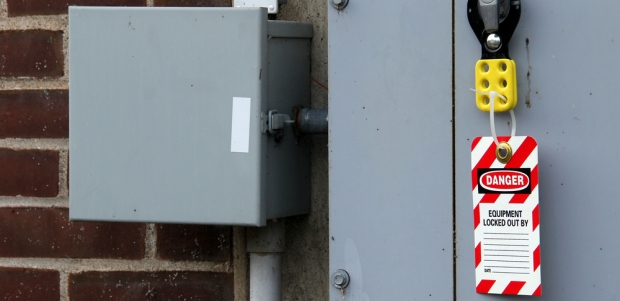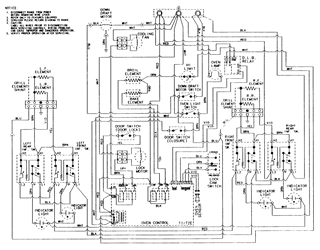
Lockout/Tagout (LOTO): Electrical Safety Simplified
LOTO is an integral part of the electrical safety requirements contained in the NFPA 70E Standard for Electrical Safety in the Workplace.
OSHA Mandate: The Law
The Occupational Safety and Health Administration, OSHA, has some minimum requirements that are invoked whenever employees are going to perform installation, maintenance, or repair on equipment. There are three major sections that apply when this occurs:
- CFR 1910.147, which applies for General Industry applications
- CFR 1926.147, applicable to Construction
- CFR 1910.133 Subpart S, which directly involves electrical hazards
NFPA 70E: Industry Best Practice
The NFPA 70E standard is produced by the National Fire Protection Association, they are one of the major players when it comes to producing standards that are used for various applications in the modern world. One of their standards that is used worldwide is NFPA 70, or the National Electrical Code, more commonly referred to as the NEC. There is also NFPA 70B, which applies to maintenance standards for electrical equipment that are also interwoven into the NFPA 70E standard. The final piece is NFPA 70E, which is the commonly used standard in the United States for electrical safety, as well as being applied worldwide within certain industries. These include oil and gas production as well as paper production.
OSHA vs. 70E: Why the Two?
Although the OSHA regulations are the minimum standards for encompassing, among other things, lockout/tagout (LOTO) for electrical safety, there are several reasons why the 70E is commonly used. Historically, the NFPA appointed a new electrical safety committee in 1976 to help OSHA implement an electrical safety standard that could be quickly used as an extension of the OSH Act. Some of the requirements involved having the public involved in the adoption and modifications in the form of notice, comments, and hearings.
The standard then in common use was the NEC, and it was thought that reworking this document in this manner would entail excessive effort and might result in a document that would differ excessively from what the NEC would otherwise contain. Additionally, the NEC in its current form is used basically for electrical installations and is not directly applicable to personnel safety. The NFPA realized that a need existed for a safety standard that OSHA could promulgate and still coordinate with the NEC.
This concept and offer of cooperation was proposed to OSHA and in May 1975 OSHA responded in a positive manner, so the concept of an electrical safety standard was born.
NFPA 70E: LOTO Requirements
The terminology that is commonly used within the safety community for LOTO is an "electrically safe work condition." This refers to an area that has been deemed "safe" from electrical hazards. Some common terms that are used for both OSHA and 70E purposes are the following:
Authorized person: Someone who is permitted due to knowledge of equipment or system to lock/tag the system in a safe and controlled manner, typically equipment operators.
Qualified person: Someone who is knowledgeable of the system enough to be able not only to lock/tag the system, but also troubleshoot, repair, or maintain the system again in a safe and controlled manner, typically technicians, electricians, etc.
Affected person: Person who may be exposed to the hazards of energizing or de-energizing the equipment or system.
PPE: Personal protective equipment for electrical hazards: rubber insulating gloves for shock hazard and arc flash-rated clothing for arc flash hazards.
LOTO: Lockout/tagout, when an electrical system or equipment has been disabled to such an extent as to render the system safe from electrical hazards for interaction with personnel.
General LOTO requirements for the employer consist of the following:
1. Shall implement a LOTO program that will include written procedures for their electrical systems.
2. Provide necessary equipment for LOTO program (locks, tags, diagrams, etc.).
3. Provide documented LOTO training to all workers exposed to the hazards.
4. Should audit the LOTO program as a whole to ensure compliance with the written program.
5. Also should audit individual personnel who implement the LOTO procedure to ensure compliance and maintain documentation of the audit.
LOTO preparations should include the following:
1. Any person who may be exposed to the electrical energy should be party to the LOTO procedure.
2. A written LOTO procedure should be developed for each system or piece of electrical equipment.
3. Up-to-date and accurate documentation should be referenced when developing the LOTO process. This will address all forms of energy and ensure that hazard exposure is minimized (eliminated).
4. LOTO is applied only to power sources, not controls. (LOTO breaker, not on/off switch).
5. LOTO equipment unique (don't use LOTO locks for lockers, etc.).

Up-to-date and accurate schematics are required for LOTO.
LOTO equipment shall consist of the following: Any equipment installed/updated/replaced/modified after January 1990 should accept a lock in the open (off) position. The employer provides the lock, but the employee has the responsibility to use the lock when working on equipment. The lock should have only one key, its combination known to only one person, and identify who placed the lock on equipment (name, face, department, phone number, etc.). It should prevent operation of equipment without undue force or tools (using a crowbar or grinder to bypass). Equipment should have a tag that displays "Do not use, Do not operate, etc." Equipment should be suitable for the environment (paper tag inside a water tank not permitted). Use tagout only if it is not possible to apply a lock, and this must use two isolation means (open breaker and remove cable from lug).
LOTO procedure will include the following: Locating sources of energy on up-to-date, accurate single line diagrams and also identifying any personnel that are in hazardous positions for the purpose of LOTO and any PPE required for their location. Also identify the person who is responsible for the LOTO. This will provide for types of LOTO: Simple LOTO only has one source of energy and involves only qualified personnel. Complex LOTO involves multiple power sources, crafts, departments, etc.
Exception: A written procedure is not required if there is only a single source of energy, one single LOTO will isolate all energy to said equipment, the LOTO is under exclusive control of a single qualified person.
LOTO control elements shall consist of the following:
1. The shutdown procedure and the qualified person responsible.
2. Shall include methods for removal of all stored energy from equipment/system.
3. Shall include disconnecting means verification. Ensure that the equipment is turned off.
4. Identify the responsible qualified person charged with coordinating LOTO as a whole.
5. Verify that the equipment/system cannot be restarted or energized. Attempt to start system, depress on button, attempt to close disconnect, etc.
6. Test target circuit/equipment to verify lack of energy. This process will consist of the following steps:
a) Verify test instrument on known good live source to verify test equipment is working properly.
b) Measure test circuit/equipment to verify no energy is present. Two steps are required:
1. Check zero energy on phase to phase measurement. Test each of the 1ɸ/3ɸ.
2. Check zero energy on phase to ground measurement. Test each of the 1ɸ/3ɸ.
c) Re-verify test instrument on known good live source to verify test equipment is still working properly.
7. Grounding requirements shall be examined. Generally, if there is danger of backfeed or the circuit is rated over 600V, then personnel safety grounding should be implemented.
These are some of the major points to take into account when realizing an electrical LOTO program.
Conclusions for LOTO
These are general guidelines, and anyone implementing or designing a LOTO program should reference the OSHA regulations as well as the NFPA 70E for further guidance.
At the end of the day, everyone's goal is to return home safely to their loved ones, without injury. Implementing and following through with a sound electrical safety program and proper electrical safety training, including LOTO, is a giant step toward reaching that goal.
This article originally appeared in the March 2019 issue of Occupational Health & Safety.